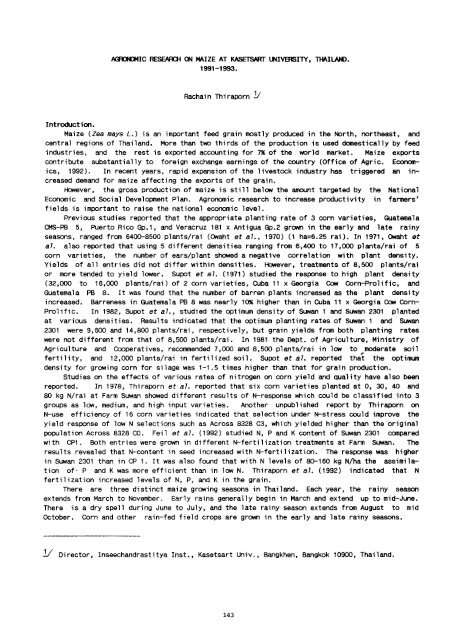Proceedings of the Fifth Asian Regional Maize Workshop - Search ...
Proceedings of the Fifth Asian Regional Maize Workshop - Search ...
Proceedings of the Fifth Asian Regional Maize Workshop - Search ...
Create successful ePaper yourself
Turn your PDF publications into a flip-book with our unique Google optimized e-Paper software.
A.<br />
1991-1993.<br />
Rachain Thiraporn !I<br />
Introduction.<br />
<strong>Maize</strong> (Zea mays L.) is an important feed grain mostly produced in <strong>the</strong> North, nor<strong>the</strong>ast, and<br />
central regions <strong>of</strong> Thailand. More than two thirds <strong>of</strong> <strong>the</strong> production is used domestically by feed<br />
industries, and <strong>the</strong> rest is exported accounting for 7~ <strong>of</strong> <strong>the</strong> world market. <strong>Maize</strong> exports<br />
contribute substantially to foreign exchange earnings <strong>of</strong> <strong>the</strong> country (Office <strong>of</strong> Agric. Economics,<br />
1992). In recent years, rapid expansion <strong>of</strong> <strong>the</strong> livestock industry has triggered an increased<br />
demand for maize affecting <strong>the</strong> exports <strong>of</strong> <strong>the</strong> grain.<br />
However, <strong>the</strong> gross production <strong>of</strong> maize is still below <strong>the</strong> amount targeted by <strong>the</strong> National<br />
Economic and Social Development Plan. Agronomic research to increase productivity in farmers'<br />
fields is important to raise <strong>the</strong> national economic level.<br />
Previous studies reported that <strong>the</strong> appropriate planting rate <strong>of</strong> 3 corn varieties, Guatemala<br />
CMS-PB 5, Puerto Rico Gp.1, and Veracruz 181 x Antigua Gp.2 grown in <strong>the</strong> early and late rainy<br />
seasons, ranged from 6400-8500 plants/rai (OWaht et a7., 1970) (1 ha=6.25 rai). In 1971, OWaht at<br />
a7. also reported that using 5 different densities ranging from 6,400 to 17,000 plants/rai <strong>of</strong> 5<br />
corn varieties, <strong>the</strong> number <strong>of</strong> ears/plant showed a negative correlation with plant density.<br />
Yields <strong>of</strong> all entries did not differ Within densities. However, treatments <strong>of</strong> 8,500 plants/rai<br />
or more tended to yield lower. Supot et a7. (1971) studied <strong>the</strong> response to high plant density<br />
(32,000 to 16,000 plants/rai) <strong>of</strong> 2 corn varieties, CUba 11 x Georgia Cow Corn-Prolific, and<br />
Guatemala PB 8. It was found that <strong>the</strong> number <strong>of</strong> barren plants increased as <strong>the</strong> plant density<br />
increased. Barreness in Guatemala PB 8 was nearly 1~ higher than in CUba 11 x Georgia Cow Corn<br />
Prolific. In 1982, SUpot et a7., studied <strong>the</strong> optimum density <strong>of</strong> SUWan 1 and SUWan 2301 planted<br />
at various densities. Results indicated that <strong>the</strong> optimum planting rates <strong>of</strong> Suwan 1 and SUWan<br />
2301 were 9,500 and 14,800 plants/rai, respectively, but grain yields from both planting rates<br />
were not different from that <strong>of</strong> 8,500 plants/rai. In 1981 <strong>the</strong> Dept. <strong>of</strong> Agriculture, Ministry <strong>of</strong><br />
Agriculture and Cooperatives, recommended 7,000 and 8,500 plants/rai in low to , moderate soil<br />
fertility, and 12,000 plants/rai in fertilized soil. SUpot et a7. reported that <strong>the</strong> optimum<br />
density for growing corn for silage was 1-1.5 times higher than that for grain production.<br />
Studies on <strong>the</strong> effects <strong>of</strong> various rates <strong>of</strong> nitrogen on corn yield and quality have also been<br />
reported. In 1978, Thiraporn et a7. reported that six corn varieties planted at 0, 30, 40 and<br />
80 kg N/rai at Farm Suwan showed different results <strong>of</strong> N-response which could be classified into 3<br />
groups as low, medium, and high input varieties. Ano<strong>the</strong>r unpublished report by Thiraporn on<br />
N-use efficiency <strong>of</strong> 16 corn varieties indicated that selection under N-stress could improve <strong>the</strong><br />
yield response <strong>of</strong> low N selections such as Across 8328 C3, which yielded higher than <strong>the</strong> original<br />
population Across 8328 CO. Feil et a7. (1992) stUdied N, P and K content <strong>of</strong> Suwan 2301 compared<br />
with CPl. Both entries were grown in different N-fertilization treatments at Farm SUWan. The<br />
results revealed that N-content in seed increased with N-fertilization. The response was higher<br />
in SUWan 2301 than in CP 1. It was also found that with N levels <strong>of</strong> 80-160 kg N/ha <strong>the</strong> assimilation<br />
<strong>of</strong>- P and K was more efficient than in low N. Thiraporn et a7. (1992) indicated that N<br />
fertilization increased levels <strong>of</strong> N, P, and K in <strong>the</strong> grain.<br />
There are three distinct maize growing seasons in Thailand. Each year, <strong>the</strong> rainy season<br />
extends from March to November. Early rains generally begin in March and extend up to mid-June.<br />
There is a dry spell during June to July, and <strong>the</strong> late rainy season extends from August to mid<br />
OCtober. Corn and o<strong>the</strong>r rain-fed field crops are grown in <strong>the</strong> early and late rainy seasons.<br />
!Ji Director, Inseechandrastitya Inst., Kasetsart Univ., Bangkhen, Bangkok 10900, Thailand.<br />
143

















